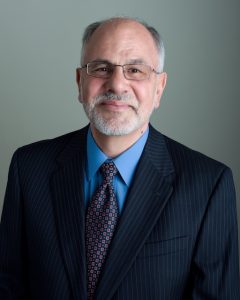 Regents’ Professor, Departments of Nuclear Engineering, Mechanical Engineering, and Chemical & Biological Engineering
Regents’ Professor, Departments of Nuclear Engineering, Mechanical Engineering, and Chemical & Biological Engineering
Founding Director, Institute of Space and Nuclear Power Studies
The University of New Mexico
Dr. El-Genk has disclosed 11 inventions to STC, received three UNM-affiliated issued U. S. patents, and has four pending U. S. patent applications for his nuclear power and reactor technologies.
The generation-IV, helium-cooled, very high-temperature reactor (VHTR) concept is currently being proposed as the next generation nuclear plant for the production of electricity and co-production of hydrogen. A fully passive, self-regulating heat exchanger with no single point failures to transport 20-50 percent of the reactor power the distance to the hydrogen production complex, reliably and with minimal energy loss, is necessary for the development of next generation nuclear plants.
Dr. El-Genk’s heat-pipe exchanger technology is a hybrid heat-pipe/thermosyphon intermediate heat exchanger (HEX) which thermally couples the VHTR primary coolant loop over a large distance to the hydrogen production complex of a next generation nuclear plant. The heat pipes and thermosyphons are passive and self-contained, energy transport devices that use a combination of capillary action and gravity for circulating the working fluid.
Ensuring access to a reliable energy supply, and clean air and water are major challenges the world faces today. The United Nations estimates that nearly one billion people have unreliable access to electricity and fresh water. A continuous supply of electricity is critical to economic and industrial growth, and raising standards of living. One of the ways to secure an electricity supply is through small modular nuclear reactors (SMRs).
Dr. El-Genk’s small modular reactor concept is the Scalable LIquid-Metal cooled, small Modular (SLIMM) reactor. It operates fully passive, except for the control drives, and is capable of generating 100 MWth (thermal megawatts) continuously for more than five years and as little as 20 MWth for more than 60 years, without refueling. The SLIMM reactor core is cooled by naturally circulating liquid sodium, with the aid of in-vessel tall chimney and heat exchanger of helically coiled tubes, during nominal operation and also after shutdown.
Dr. El-Genk’s research focuses on the following areas: boiling and convection heat transfer; space nuclear power and radioisotope power systems for space exploration and planetary surface power and human outposts; nuclear thermal propulsion for planetary missions; space radiation and environmental effects; high temperature materials and nuclear fuel; static and dynamic energy conversion; nuclear reactors design, thermal-hydraulics and safety; heat pipes, thermosyphons, thermal management and advanced cooling of electronics; Computational Fluid Dynamics (CFD) of nuclear reactors and energy systems; and Molecular Dynamics (MD) simulation of radiation damage to materials.
ISSUED U. S. PATENTS (UNM-AFFILIATED)
5,106,574 Nuclear Reactor Refuelable in Space, issued April 21, 1992
5,428,653 Apparatus and Method for Nuclear Power and Propulsion, issued June 27, 1995
8,073,096 Methods and Apparatuses for Removal and Transport of Thermal Energy, issued December 6, 2011
PENDING U. S. PATENT APPLICATIONS (UNM-AFFILIATED)
SLIMM-Scalable Liquid Metal Cooled Small Modular Reactor
Methods of Fabricating Nanoporous and Radiation Hard Oxide Particles Adsorbent of Noble Gases Fission Products
Long-Life, Portable Reactor for Terrestrial Power Systems (LPORTS)
Long-Life, Modular and Portable Reactor (LMPOR) for Terrestrial Power

